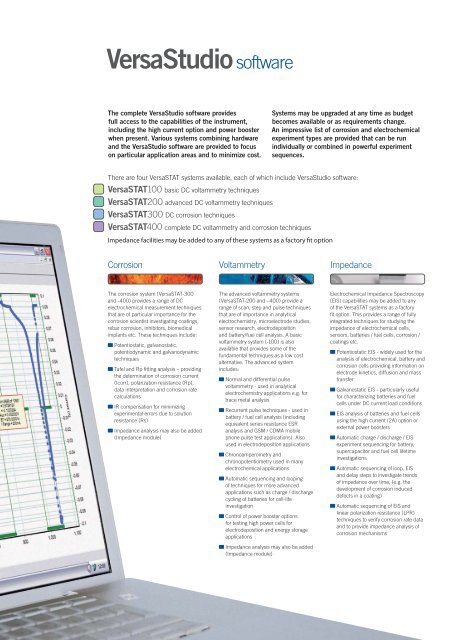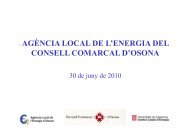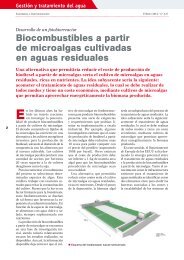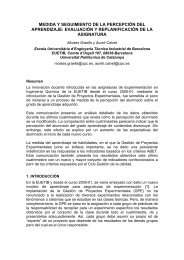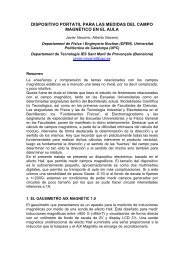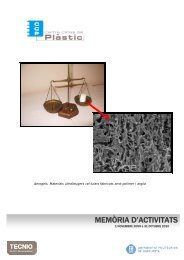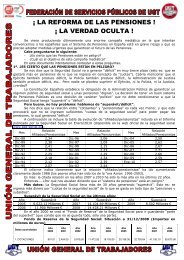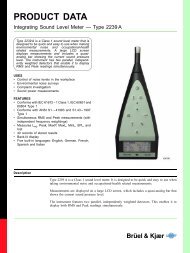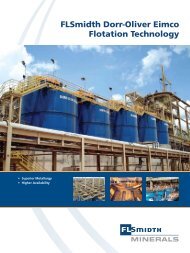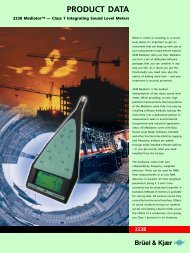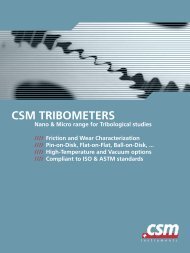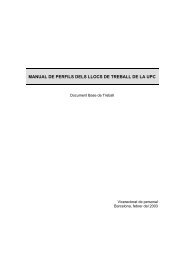VersaSTAT Series Brochure A4.indd - UPC
VersaSTAT Series Brochure A4.indd - UPC
VersaSTAT Series Brochure A4.indd - UPC
Create successful ePaper yourself
Turn your PDF publications into a flip-book with our unique Google optimized e-Paper software.
VersaStudio software<br />
The complete VersaStudio software provides<br />
full access to the capabilities of the instrument,<br />
including the high current option and power booster<br />
when present. Various systems combining hardware<br />
and the VersaStudio software are provided to focus<br />
on particular application areas and to minimize cost.<br />
Systems may be upgraded at any time as budget<br />
becomes available or as requirements change.<br />
An impressive list of corrosion and electrochemical<br />
experiment types are provided that can be run<br />
individually or combined in powerful experiment<br />
sequences.<br />
There are four <strong>VersaSTAT</strong> systems available, each of which include VersaStudio software:<br />
<strong>VersaSTAT</strong>100 basic DC voltammetry techniques<br />
<strong>VersaSTAT</strong>200 advanced DC voltammetry techniques<br />
<strong>VersaSTAT</strong>300 DC corrosion techniques<br />
<strong>VersaSTAT</strong>400 complete DC voltammetry and corrosion techniques<br />
Impedance facilities may be added to any of these systems as a factory fit option<br />
Corrosion<br />
Voltammetry<br />
Impedance<br />
The corrosion system (<strong>VersaSTAT</strong>-300<br />
and -400) provides a range of DC<br />
electrochemical measurement techniques<br />
that are of particular importance for the<br />
corrosion scientist investigating coatings,<br />
rebar corrosion, inhibitors, biomedical<br />
implants etc. These techniques include:<br />
Potentiostatic, galvanostatic,<br />
potentiodynamic and galvanodynamic<br />
techniques<br />
Tafel and Rp fi tting analysis – providing<br />
the determination of corrosion current<br />
(Icorr), polarization resistance (Rp),<br />
data interpretation and corrosion rate<br />
calculations<br />
IR compensation for minimizing<br />
experimental errors due to solution<br />
resistance (Rs)<br />
Impedance analysis may also be added<br />
(Impedance module)<br />
The advanced voltammetry systems<br />
(<strong>VersaSTAT</strong>-200 and –400) provide a<br />
range of scan, step and pulse techniques<br />
that are of importance in analytical<br />
electrochemistry, microelectrode studies,<br />
sensor research, electrodeposition<br />
and battery/fuel cell analysis. A basic<br />
voltammetry system (-100) is also<br />
available that provides some of the<br />
fundamental techniques as a low cost<br />
alternative. The advanced system<br />
includes:<br />
Normal and differential pulse<br />
voltammetry - used in analytical<br />
electrochemistry applications e.g. for<br />
trace metal analysis<br />
Recurrent pulse techniques - used in<br />
battery / fuel cell analysis (including<br />
equivalent series resistance ESR<br />
analysis and GSM / CDMA mobile<br />
phone pulse test applications). Also<br />
used in electrodeposition applications<br />
Chronoamperometry and<br />
chronopotentiometry used in many<br />
electrochemical applications<br />
Automatic sequencing and looping<br />
of techniques for more advanced<br />
applications such as charge / discharge<br />
cycling of batteries for cell-life<br />
investigation<br />
Control of power booster options<br />
for testing high power cells for<br />
electrodeposition and energy storage<br />
applications<br />
Impedance analysis may also be added<br />
(Impedance module)<br />
Electrochemical Impedance Spectroscopy<br />
(EIS) capabilities may be added to any<br />
of the <strong>VersaSTAT</strong> systems as a factory<br />
fi t option. This provides a range of fully<br />
integrated techniques for studying the<br />
impedance of electrochemical cells,<br />
sensors, batteries / fuel cells, corrosion /<br />
coatings etc.<br />
Potentiostatic EIS - widely used for the<br />
analysis of electrochemical, battery and<br />
corrosion cells providing information on<br />
electrode kinetics, diffusion and mass<br />
transfer<br />
Galvanostatic EIS - particularly useful<br />
for characterizing batteries and fuel<br />
cells under DC current load conditions<br />
EIS analysis of batteries and fuel cells<br />
using the high current (2A) option or<br />
external power boosters<br />
Automatic charge / discharge / EIS<br />
experiment sequencing for battery,<br />
supercapacitor and fuel cell lifetime<br />
investigations<br />
Automatic sequencing of loop, EIS<br />
and delay steps to investigate trends<br />
of impedance over time, (e.g. the<br />
development of corrosion induced<br />
defects in a coating)<br />
Automatic sequencing of EIS and<br />
linear polarization resistance (LPR)<br />
techniques to verify corrosion rate data<br />
and to provide impedance analysis of<br />
corrosion mechanisms


